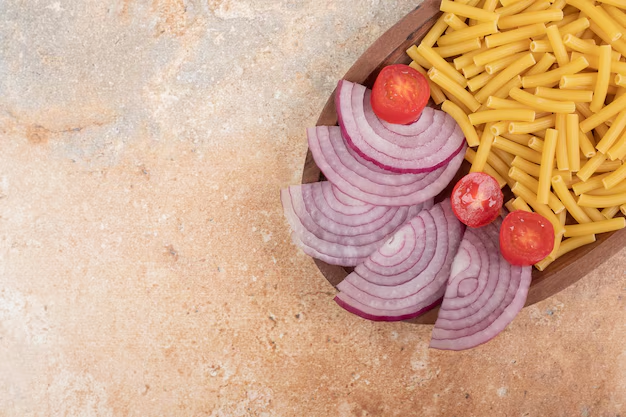Can You Store Cut Onions in the Refrigerator?
Have you ever chopped an onion for a recipe and wondered what to do with the leftovers? Storing food properly can make a significant difference in both flavor and shelf life. Onions, in particular, can pose a bit of a puzzle. Should you leave them on the counter, or is the refrigerator a better option? Let’s explore whether it's okay to put cut onions in the refrigerator and delve into related topics that can help enhance your food storage skills.
Why Proper Storage Matters
Before diving into whether refrigerators are the right home for cut onions, it's important to understand why proper storage matters. Food spoilage can lead to waste, and nobody enjoys dealing with the unpleasant aroma of rotting produce. Also, how you store onions can influence their taste and texture when cooked. Storing cut onions properly ensures your meals maintain their intended flavor profiles.
The Basics of Onion Storage
Whole Onions
Whole onions have a protective papery skin that helps them stay fresh. They thrive in cool, dry conditions with good air circulation. A pantry or a mesh basket on your countertop can work well. It's generally not recommended to store whole onions in the fridge, as the cold temperature and humidity can make them softer, affecting texture and taste.
Cut Onions
Cut onions are more vulnerable because their protective skin has been compromised. They need to be stored differently than whole onions to maintain freshness. So, is the refrigerator a suitable option?
The Refrigerator: Friend or Foe?
Benefits of Refrigerating Cut Onions
Preservation of Freshness: Refrigerating cut onions can help them last longer by slowing down the enzymatic processes that lead to spoilage.
Reduction of Smells: Onions can release strong odors, which can permeate your home if left on the counter. Storing them in the fridge can help contain their potent aroma.
Convenience: Having ready-to-use onions on hand can save meal prep time. Simply pull out the pre-cut onions and start cooking.
Considerations When Refrigerating
Proper Containment: Always store cut onions in airtight containers or tightly wrapped in plastic. This not only helps in maintaining freshness but also prevents the onion smell from contaminating other foods.
Best Containers: Glass containers with tight-fitting lids are preferred as they don't absorb smells like plastic containers might.
Shelf Life: While refrigerating cut onions prolongs their life, it’s best to use them within a week for optimal freshness and flavor.
When Not to Refrigerate
For certain recipes, refrigerated onions may become too soft or lose their sharpness. If you're preparing a dish that relies heavily on the bite and texture of fresh onions, consider chopping them fresh.
Addressing Storage Myths
Onions Absorb Bacteria: Myth or Fact?
There is a persistent myth that onions absorb bacteria, posing a health risk if stored or used after being cut. This claim lacks scientific validation. Storing cut onions in the refrigerator can actually minimize bacterial contamination by maintaining a cold environment where bacteria are less likely to thrive.
The Eyes Make You Cry: Reducing Tear-Inducing Properties
Want to cut onions without shedding tears? Refrigeration can help. Cold temperatures slow down the release of the sulfur compounds that trigger tears when chopping onions. Storing onions in the refrigerator prior to cutting can make the whole process a bit more bearable.
Related Subtopics in Onion Storage
Freezing Onions for Long-Term Storage
Freezing is an excellent option if you find yourself with an abundance of onions. Here’s how you can do it:
Peel and Chop: Prepare the onions like you would for any recipe.
Blanching: Briefly submerge the chopped onions in boiling water and then transfer them to an ice bath. This step isn’t mandatory but can preserve texture and flavor.
Freeze in Portions: Spread the onions on a baking sheet and freeze individually, then transfer to a freezer-safe container or bag. This prevents clumping and makes it easy to grab the amount you need.
Use Directly from Freezer: Frozen onions work well in cooked dishes like soups, stews, and sautés. They might not be ideal for fresh uses due to texture changes.
Other Vegetables That Prefer the Fridge
Onions aren’t the only veggies to consider for refrigeration:
- Bell Peppers: Like onions, cut peppers should be stored in airtight containers in the fridge.
- Celery and Carrots: Better maintained in the crisper drawer to prolong freshness.
- Garlic: While whole garlic is best kept in a cool, dry place, cut garlic can be refrigerated for short periods.
The Impact of Humidity and Temperature
Storing produce at the wrong temperature or humidity can shorten shelf life:
- Too Cold: Can cause unwanted textural changes in some vegetables.
- Too Warm: Speeds up spoilage through faster bacterial growth.
- Humidity Levels: Aim for moderate humidity. Too much can incite mold; too little can dry out produce.
Key Takeaways and Tips
Here’s a quick summary of storing cut onions in the refrigerator and related tips:
- ✅ Use Airtight Containers: Keep onions fresh and odor-contained.
- ✅ Consume Within a Week: For best taste and quality.
- 🚫 Avoid storing complete onions in the fridge: It affects texture and taste.
- ✅ Keep onions cold to reduce tears: Refrigerated onions can be tear-free.
- ✅ Consider Freezing: For preserving bulk purchases.
- ✅ Store in Moderation: Some recipes benefit from fresh-cut onions over stored ones.
Conclusion Insights
When it comes to storing cut onions, the refrigerator can be your ally. By adopting appropriate storage practices, such as using airtight containers and being mindful of the storage duration, you can enjoy fresher onions without the notorious smell taking over. Moreover, taking time to learn how different storage methods impact your produce can enhance your culinary experience overall. Whether you're a home cook or occasionally find yourself in the kitchen, mastering these storage techniques can lead to less waste and more flavorful dishes in your daily life.
